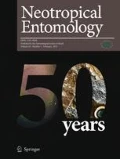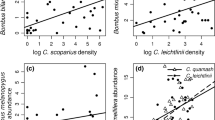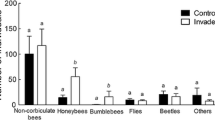Abstract
Invasive social bees can alter plant-pollinator interactions with detrimental effects on both partners. However, most studies have focused on one invasive bee species, while the interactions among two or more species remain poorly understood. Also, many study sites had a history of invasive bees, being hard to find sites with historical low abundances. In Patagonia, Bombus ruderatus (F.) invasion begun in 1993 and B. terrestris (L.) in 2006. Though honey bees (Apis mellifera L.) introduction started in 1859, their density is still low in some parts. By experimentally increasing honey bee densities, we evaluated the effect of honey bees and bumblebees floral visitation on native pollinator floral visitation, pollen deposition, and reproductive success of three plant species in mixed Nothofagus antarctica forests of northern Patagonia: Oxalis valdiviensis, Mutisia spinosa and Cirsium vulgare. Our results show that exotic bees became the main floral visitors. No negative association was found between invasive bee and native pollinator visitation rates, but there was evidence of potential competition between honey bees and bumblebees. Floral neighborhood diversity played an important role in pollinator behavior. Conspecific pollen deposition was high for all species, while deposition of heterospecific pollen was very high in M. spinosa and C. vulgare. Not as expected, honey bees visitation rate had a negative effect on heterospecific pollen deposition in C. vulgare. For O. valdiviensis, exotic visitation rates increased conspecific pollen deposition, which was positively related to reproductive success. Although exotic bees became main floral visitors, their contribution to reproductive success was only clear for one species.



Similar content being viewed by others
References
Abid R (2010) Floral morphs and mode of pollination in Oxalis corniculata L. from Pakistan. Pak J Bot 42(6):4027–4033
Abrol DP (2012) Pollination biology: biodiversity conservation and agricultural production. Springer, New York
Agüero JI, Rollin O, Torretta JP, Aizen MA, Requier F, Garibaldi LA (2018) Impactos de la abeja melífera sobre plantas y abejas silvestres en hábitats naturales. Revista Ecosistemas 27(2):60–69
Ainur AK, Sayang MD, Jannoo Z, Yap BW (2017) Sample size and non-normality effects on goodness of fit measures in structural equation models. Pertanika J Sci Technol 25(2)
Aizen MA, Ezcurra C (1998) High incidence of plant-animal mutualisms in the woody flora of the temperate forest of southern South America: biogeographical origin and present ecological significance. Doctoral dissertation, Asociación Argentina de Ecología
Aizen MA, Harder LD (2007) Expanding the limits of the pollen-limitation concept: effects of pollen quantity and quality. Ecology 88(2):271–281
Aizen MA, Morales CL, Morales JM (2008) Invasive mutualists erode native pollination webs. PLoS Biol 6(2):e31
Arceo-Gómez G, Ashman TL (2011) Heterospecific pollen deposition: does diversity alter the consequences? New Phytol 192(3):738–746
Bruckman D, Campbell DR (2014) Floral neighborhood influences pollinator assemblages and effective pollination in a native plant. Oecologia 176(2):465–476
Coulin C, Aizen MA, Garibaldi LC (2019) Contrasting responses of plants and pollinators to woodland disturbance. Austral Ecol 44(6):1040–1051
De Jong TJ, Klinkhamer PG (1989) Limiting factors for seed production in Cynoglossum officinale. Oecologia 80(2):167–172
Dohzono I, Kunitake YK, Yokoyama J, Goka K (2008) Alien bumble bee affects native plant reproduction through interactions with native bumble bees. Ecology 89(11):3082–3092
Fenner M, Cresswell JE, Hurley RA, Baldwin T (2002) Relationship between capitulum size and pre-dispersal seed predation by insect larvae in common Asteraceae. Oecologia 130(1):72–77
Fyfe VC (1950) The genetics of tristyly in Oxalis valdiviensis. Heredity (Edinb) 4(3):365–371
Ghazoul J (2006) Floral diversity and the facilitation of pollination. J Ecol 94(2):295–304
Giurfa M, Nunez J, Chittka L, Menzel R (1995) Colour preferences of flower-naive honeybees. J Comp Physiol A 177(3):247–259
Goulson D (2003) Effects of introduced bees on native ecosystems. Annu Rev Ecol Evol Syst 34:1–26
Goulson D (2010) Choice of flower species. In: Goulson D (ed) Bumblebees: behaviour, ecology, and conservation. Oxford University Press, Oxford, pp 113–129
Grüter C, Ratnieks FL (2011) Flower constancy in insect pollinators: adaptive foraging behaviour or cognitive limitation? Commun Integr Biol 4(6):633–636
Guth CJ, Weller SG (1986) Pollination, fertilization and ovule abortion in Oxalis magnifica. Am J Bot 73(2):246–253
Gyenge J, Fernández ME, Sarasola M, de Urquiza M, Schlichter T (2009) Ecuaciones para la estimación de biomasa aérea y volumen de fuste de algunas especies leñosas nativas en el valle del río Foyel, NO de la Patagonia argentina. Bosque (Valdivia) 30(2):95–101
Hu LT, Bentler PM (1999) Cutoff criteria for fit indexes in covariance structure analysis: conventional criteria versus new alternatives. Struct Equ Model Multidiscip J 6(1):1–55
Hung KLJ, Kingston JM, Albrecht M, Holway DA, Kohn JR (2018) The worldwide importance of honey bees as pollinators in natural habitats. Proc R Soc Lond B Biol Sci 285(1870):20172140
Lande R (1996) Statistics and partitioning of species diversity, and similarity among multiple communities. Oikos 76:5–13
Madjidian JA, Morales CL, Smith HG (2008) Displacement of a native by an alien bumblebee: lower pollinator efficiency overcome by overwhelmingly higher visitation frequency. Oecologia 156(4):835–845
Magrach A, González-Varo JP, Boiffier M, Vilà M, Bartomeus I (2017) Honeybee spillover reshuffles pollinator diets and affects plant reproductive success. Nat Ecol Evol 1(9):129
Mallinger RE, Gaines-Day HR, Gratton C (2017) Do managed bees have negative effects on wild bees?: a systematic review of the literature. PLoS One 12(12):e0189268
Maloof JE, Inouye DW (2000) Are nectar robbers cheaters or mutualists? Ecology 81(10):2651–2661
Marrero HJ, Medan D, Zarlavsky GE, Torretta JP (2016) Agricultural land management negatively affects pollination service in Pampeanagro-ecosystems. Agric Ecosyst Environ 218:28–32
Mendes do Carmo R, Franceschinelli EV, Silveira FA (2004) Introduced honeybees (Apis mellifera) reduce pollination success without affecting the floral resource taken by native pollinators. Biotropica 36:371–376
Michaux B (1989) Reproductive and vegetative biology of Cirsium vulgare (Savi) ten. (Compositae: Cynareae). New Zeal J Bot 27(3):401–414
Mitchell RJ (1992) Testing evolutionary and ecological hypotheses using path analysis and structural equation modelling. Funct Ecol 6:123–129
Molina-Montenegro MA, Badano EI, Cavieres LA (2008) Positive interactions among plant species for pollinator service: assessing the “magnet species” concept with invasive species. Oikos 117(12):1833–1839
Morales CL, Aizen MA (2002) Does invasion of exotic plants promote invasion of exotic flower visitors? A case study from the temperate forests of the southern Andes. Biol Invasions 4(1–2):87–100
Morales CL, Aizen MA (2006) Invasive mutualisms and the structure of plant-pollinator interactions in the temperate forests of north-West Patagonia, Argentina. J Ecol 94(1):171–180
Morales CL, Arbetman MP, Cameron SA, Aizen MA (2013) Rapid ecological replacement of a native bumble bee by invasive species. Front Ecol Environ 11(10):529–534
Morales CL, Traveset A (2009) A meta-analysis of impacts of alien vs. native plants on pollinator visitation and reproductive success of co-flowering native plants. Ecol Lett 12(7):716–728
Morales CL, Traveset A (2008) Interspecific pollen transfer: magnitude, prevalence and consequences for plant fitness. CRC Crit Rev Plant Sci 27(4):221–238
Morales C, Traveset A, Ramírez N (2009) Especies invasoras y mutualismos planta-animal. In: Medel R, Aizen MA, Zamora R (eds) Ecología y evolución de interacciones planta-animal. Editorial Universitaria, Santiago de Chile, pp 61–76
Moritz RFA, Härtel S, Neumann P (2005) Global invasions of the western honeybee (Apis mellifera) and the consequences for biodiversity. Ecoscience 12:289–301
Muñoz AA, Cavieres LA (2008) The presence of a showy invasive plant disrupts pollinator service and reproductive output in native alpine species only at high densities. J Ecol 96(3):459–467
Niesenbaum RA (1993) Light or pollen--seasonal limitations on female reproductive success in the understory shrub Lindera benzoin. J Ecol 81:315–323
Paini DR, Roberts JD (2005) Commercial honey bees (Apis mellifera) reduce the fecundity of an Australian native bee (Hylaeus alcyoneus). Biol Conserv 123(1):103–112
Paton D (1997) Honey bees Apis mellifera and the disruption of plant-pollinator systems in Australia. Vic Nat 114:23–29
Pérez Rosales V (1859) Ensayo sobre Chile. Librería del Ferrocarril, Santiago de Chile
Reque JA, Sarasola M, Gyenge J, Fernández ME (2007) Caracterización silvícola de ñirantales del norte de la Patagonia para la gestión forestal sostenible. Bosque (Valdivia) 28(1):33–45
Roig-Alsina A, Aizen MA (1996) Bombus ruderatus Fabricius, un nuevo Bombus para la Argentina (Hymenoptera: Apidae). Physis 5:49–50
Rosseel Y (2012) Lavaan: an R package for structural equation modeling and more. Version 0.5–12 (BETA). J Stat Softw 48(2):1–36
Sanguinetti A, Singer RB (2014) Invasive bees promote high reproductive success in Andean orchids. Biol Conserv 175:10–20
de M Santos GM, Aguiar CML, Genini J, Martins CF, Zanella FCV, Mello MAR (2012) Invasive Africanized honey bees change the structure of native pollination networks in Brazil. Biol Invasions 14(11):2369–2378
Sih A, Baltus MS (1987) Patch size, pollinator behavior, and pollinator limitation in catnip. Ecology 68(6):1679–1690
Simpson EH (1949) Measurement of diversity. Nature 163(4148):688
Speziale KL, Ruggiero A, Ezcurra C (2010) Plant species richness–environment relationships across the Subantarctic–Patagonian transition zone. J Biogeogr 37(3):449–464
Stout JC, Goulson D (2001) The use of conspecific and interspecific scent marks by foraging bumblebees and honey bees. Anim Behav 62(1):183–189
Stout JC, Morales CL (2009) Ecological impacts of invasive alien species on bees. Apidologie 40(3):388–409
Thomson D (2004) Competitive interactions between the invasive European honey bee and native bumble bees. Ecology 85(2):458–470
Torretta JP, Medan D, Abrahamovich AH (2006) First record of the invasive bumblebee Bombus terrestris (L) (Hymenoptera, Apidae) in Argentina. T Am Entomol Soc 132:285–289
Traveset A, Richardson DM (2006) Biological invasions as disruptors of plant reproductive mutualisms. Trends Ecol Evol 21:208–216
Traveset A, Richardson DM (2014) Mutualistic interactions and BiologicalInvasions. Annu Rev Ecol Evol Syst 45:89–113
Valido A, Rodríguez-Rodríguez MC, Jordano P (2019) Honey bees disrupt the structure and functionality of plant-pollinator networks. Sci Rep 9(1):471
Waters SM, Fisher SE, Hille Ris Lambers J (2014) Neighborhood-contingent indirect interactions between native and exotic plants: multiple shared pollinators mediate reproductive success during invasions. Oikos 123(4):433–440
Weller SG (1981) Fecundity in populations of Oxalis alpina in southeastern Arizona. Evolution 35(1):197–200
Zarlavsky GE (2014) Histología vegetal: técnicas simples y complejas. Gráfica Arte, Buenos Aires, pp 127–128
Zuloaga FO, Belgrano MJ (2017) Flora Argentina: Flora Vascular de La República Argentina. http://wwwfloraargentinaeduar/ Accessed 26 July 2019
Acknowledgments
We are grateful to C. Coulin and A. Antokoletz, G. J. Huerta, C.A. John and D. H. Bascur for their vital contribution to the project. We also thank G. Zarlavsky and B. G. Galati for their collaboration in pollen analysis. We are grateful to Márcia Maués, Carmen Pires and Cláudia Inês Silva for inviting us to participate in this Special Volume of Neotropical Entomology. The manuscript benefited from critical reading of two anonymous reviewers. This research was funded by Agencia Nacional de Promoción Científica y Tecnológica (PICT 2013-1079 and PICT 2016-0305). JIA, NPM, JPT and LAG are affiliated with CONICET.
Author information
Authors and Affiliations
Contributions
JIA and LAG contributed to the design and implementation of the research. JIA, NPM, JPT and LAG contributed to the analysis of the results and to the writing of the manuscript. LAG supervised the project since its original idea. All authors approved the final version of the manuscript.
Corresponding author
Additional information
Edited by Márcia M Maués – Embrapa
Publisher’s Note
Springer Nature remains neutral with regard to jurisdictional claims in published maps and institutional affiliations.
Appendix
Appendix
Theoretical path diagram incorporating all the hypothetical causal relationships between the variables of interest for the three studied plant species. Variables: Simpson’s diversity (1-D), honey bees v. r. (honey bees visitation rate), native pollinators v. r. (mean native pollinators visitation rate), bumblebees v. r. (mean Bombus terrestris and B. ruderatus visitation rate), conspecific pollen grains, heterospecific pollen grains and reproductive success (number of viable seeds/ total number of ovules for O. valdiviensis or healthy/ total number of achenes for M. spinosa and C. vulgare). Full lines represent positive effects and dotted lines negative effects
Rights and permissions
About this article
Cite this article
Agüero, J.I., Pérez-Méndez, N., Torretta, J.P. et al. Impact of Invasive Bees on Plant-Pollinator Interactions and Reproductive Success of Plant Species in Mixed Nothofagus antarctica Forests. Neotrop Entomol 49, 557–567 (2020). https://doi.org/10.1007/s13744-020-00787-6
Received:
Accepted:
Published:
Issue Date:
DOI: https://doi.org/10.1007/s13744-020-00787-6





